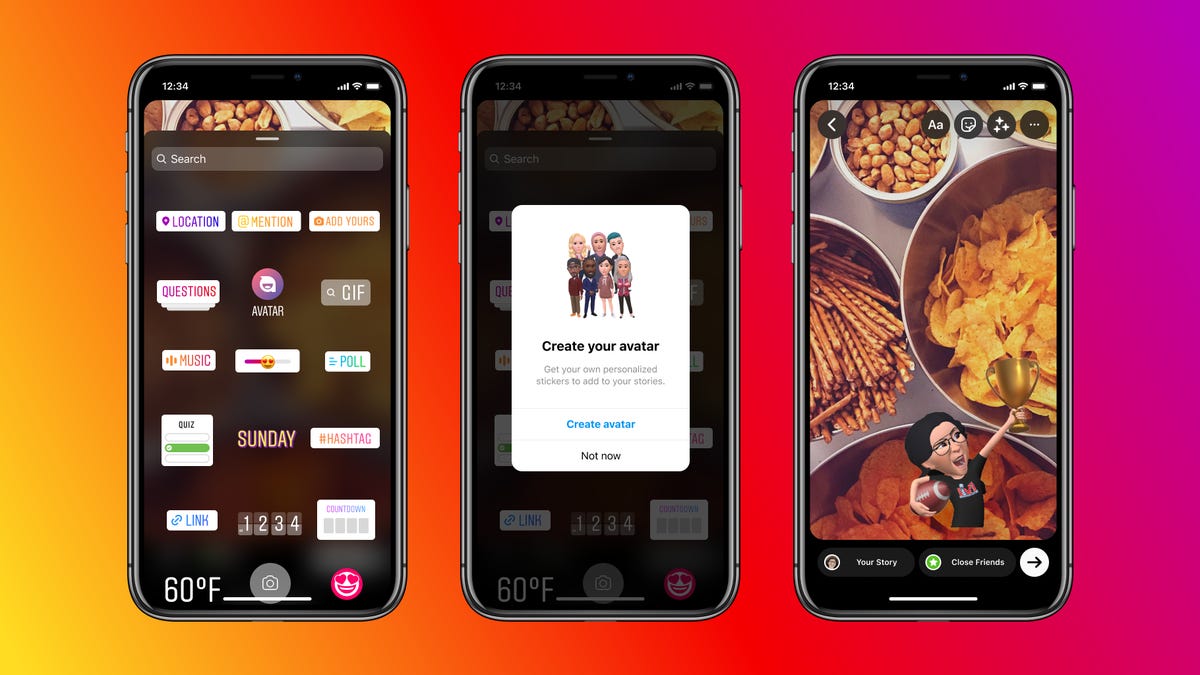Facebook's latest metaverse move: Dropping avatars into Instagram
3D avatars are coming to Messenger, Facebook and Instagram, along with Super Bowl-themed shirts. Meta's head of Avatars explains to CNET what's going on.

Avatars will appear as stickers in apps like Instagram.
Facebook changed its company name to Meta last fall, promising an upcoming metaverse-focused strategy that would blend VR, AR, and the company's existing social media platforms. Today, Meta announced that its 3D VR avatars would start showing up on the company's other apps: Facebook, Messenger and Instagram. Meta's also dipping its toes into promotional gear for avatars, introducing limited-time Super Bowl-themed jerseys. But it's not exactly the cross-platform metaverse move VR fans might expect.
The existing avatar-creation tools that are already on the Oculus Quest 2 (or is it Meta Quest 2 now?) and were updated last year will start appearing on other Facebook apps, but using them beyond profile images will mainly happen through sticker-pack-type emoji for now. Much like Bitmoji or Apple's Memoji, the avatars will be animated with expressions that can be sent in messages on Messenger, or put into Instagram posts. The update comes alongside some additional avatar customizations that will carry over into Oculus Quest, adding expanded skin shaders, wheelchairs, hearing aids, and cochlear implants.
The announcement comes along with a Super Bowl-themed promo that will introduce Bengals or Rams-themed shirts that can be added to avatars for free, but only for a limited time. The jerseys and gear will disappear at the end of February after the experiment ends, and accounts won't get to keep any of the gear.
The avatar changes are coming to the US, Mexico and Canada to start, but are expected to expand to other regions next.
Facebook already had avatar profile image options before, but the update adds 3D animations. For Instagram, the avatar addition is completely new.
This is what Facebook avatars could start looking like.
"We see the metaverse as this interconnected digital world, one that bridges VR, AR mobile and computer. Being able to offer avatars across all the platforms is one of our first steps towards making this vision for the metaverse a reality," Aigerim Shorman, Meta's GM of Avatars and Identity Distribution, said about the changes to CNET in a conversation over Zoom.
While the avatar tools are expanding to Facebook's other platforms, Meta still isn't allowing more than one avatar to exist per profile in any app. That possibility sounds like a future goal for Meta, but at the moment avatars are designed to be singular, and humanoid-based (customizations allow some flexibility, but nothing too out-there). "You can create different avatars on each of the apps, but right now you are not able to create multiple avatars within one app," Shorman confirmed, explaining that different avatars could stay across Messenger, Facebook and Instagram apps, or be synced to be the same.
Meta's head of Metaverse, Vishal Shah, told CNET last year that a big part of the company's avatar and metaverse strategy will be selling virtual items, either for virtual spaces or as avatar accessories. That still isn't happening here. According to Shorman, "It's a step towards that vision of finding something that's exciting and new for your clothes and accessories."
The avatars also won't seamlessly sync in the way you'd expect. Meta expects people to create additional avatars through its other apps which won't sync back to VR. Considering the much higher percentages of people using Instagram, Messenger and Facebook compared to VR, the move also seems to acknowledge that avatars may not even necessarily be incentives to get a VR headset at the moment. Instead, they seem more like metaverse placeholders for apps that don't have anything metaverse-like yet.
These avatars won't be AR-enabled yet, either, despite Facebook's promises of future AR glasses and a number of AR-enabled effects in Instagram and the company's video-chat-based Portal smart displays. That seems like an obvious move (Apple's had AR-enabled Memoji avatars for years now), but these avatars still can't be used to easily record animated messages from VR into apps like Instagram or Facebook, either. At least those features seem to still be in the works, at least according to Mark Zuckerberg's far-flung conceptual metaverse dream, which he introduced when the company changed its name last year.

